
|
xTuple ERP Reference Guide |
To add a new sales order line item, select the button. The following screen will appear:
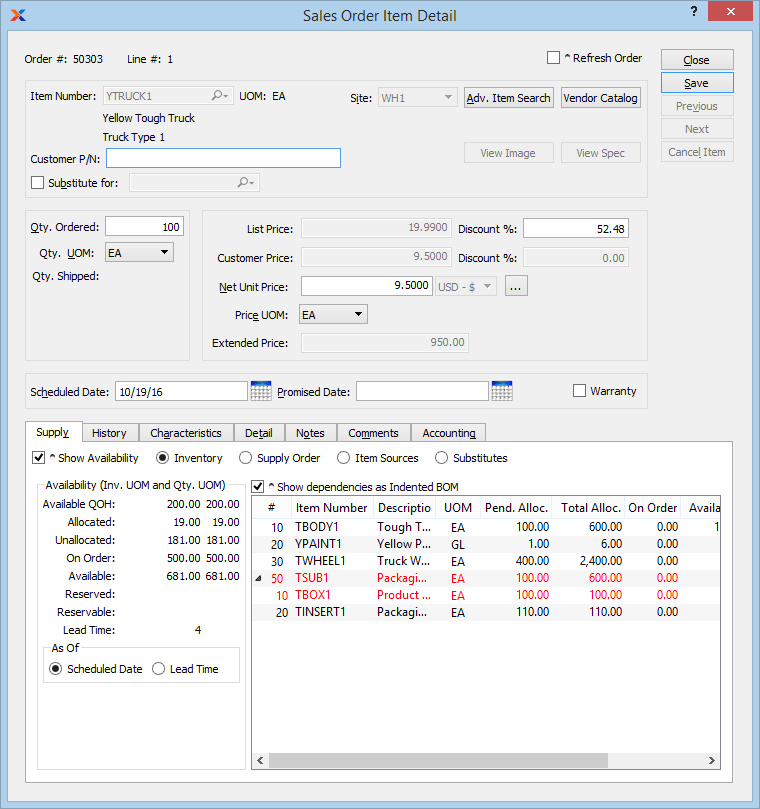
When creating a new sales order line item, you are presented with the following options:
Displays the sales order number specified on the sales order header.
Displays the line item number for the current line item.
If the sales order was generated from a return authorization, the return authorization number and corresponding line number will also be displayed at the top of the screen.
Select to indicate you want the sales order header to be refreshed immediately in the background. When the header is refreshed immediately, you will be able to see the rows of line items being added to the order. However, this feature can impact performance when entering sales order line items. If you are experiencing performance issues, you should not select this option. The sales order will be refreshed when you close the Sales Order Line Item screen.
Displays the return authorization number associated with the sales order, if any.
Displays the line number for the item listed on the return authorization, if any.
Enter the item number of the item you want to sell. The item list will contain sold items available for sale to the specified customer. The list of available items may vary from customer to customer, depending on how pricing schedules are implemented at your site. Once an item number is entered, the inventory unit of measure and item description will automatically appear.
If the item is a job item, a linked work order will automatically be created. Creating a sales order for job items is the only way to create a job item work order. Production for job item work orders is posted automatically when the linked sales order item is linked to shipping.
Kit items must be shipped complete before they can be invoiced.
Displays the customer part number (i.e., item alias) that corresponds to the item number entered in the Item Number field. If the alias is associated with a particular customer account, then the alias will only be displayed for sales orders and quotes entered for that customer. Item aliases are defined on the Item master.
Optional selection used solely for gathering information related to sales order line item substitutions. This feature can be used, for example, to gather information about inventory shortages or customer first preferences. There is no impact on the system of using this feature. Its function is simply to store information in the database, where it may be accessed for reporting purposes.
Specify the site the sales order item is sold from. Items may be supplied to sales orders from multiple item sites. After an item number is entered above, the system checks for available item sites for the item. Any item sites having the Sold From flag set on them will be selectable from this site list. By default, the item site having the highest ranking will be selected as the first available site. If more than one item site share a ranking of "1," the sites will be sorted in alphabetical order. Item site rankings are set on the Item Site master.
If a Preferred Selling Site is specified for the customer, then that site will be selected here by default. If the Preferred Selling Site is not selected—and you think it should be—verify that the Item Site master for the line item in question is marked as a Sold From site.
Advanced item search (AIS) is a feature designed specifically with distribution in mind. This feature allows distributors and end users to quickly search for both items and item aliases—as well as current inventory levels—filtering every keystroke. From this screen you also have the ability to create an item alias.
When using the AIS, you must enter at least three characters (i.e., numbers, letters or a combination of both) before any search results will be returned. This is for speed of performance reasons.
Select to use the External Vendor Catalog screen to view items as they appear within the various vendor catalogs you are subscribed to.
Select to view an item image, if available.
Select to view a specification sheet for the item, if available.
Enter the quantity of the specified item being ordered.
If the sales order item is being edited and the quantity ordered is reduced then all reservations for the line item will be removed.
Specify the unit of measure (UOM) to be used when selling the line item. Sold items may be assigned multiple Selling UOMs. These alternate UOMs may be defined on the Item master. You may also select a global conversion ratio here. Global conversions have the label Global appended to them. If a line item has no Selling UOM defined, then the inventory UOM will be used here by default.
When sales orders are entered, the system will search for quantity break matches between the sales order item and any relevant pricing schedule. If duplicate quantity breaks are found, the lowest price for the given quantity will be used.
Displays the line item quantity shipped to date, if any.
Displays either the list price found on the Item master or the alternate list price, if alternate list pricing is being used. To learn more about how alternate list pricing works, please see the Alternate List Pricing article at xTupleU.
If standard list pricing is being used, this field will display the default discount percentage (if any) for the specified customer, as defined on the Customer master. On the other hand, if alternate list pricing is being used, the field will display the percentage difference between the alternate list price and the net unit price. You also have the option to manually override the discount percentage.
Displays the best applicable price from all available pricing schedules.
Displays the percentage difference between the customer price and the net unit price.
Displays either the list price minus the customer discount or the price from any applicable pricing schedule or sale. If a pricing schedule is in effect, the most specific pricing schedule assignment will be used. The specificity of pricing schedule assignments is determined in the following descending order: by customer ship-to address (most specific), by customer, by customer type, by customer type pattern, by all customers. The lookup feature located to the right of the field leads to a Price List screen.
The system can be configured to prevent users from editing the net unit price. If your system is configured that way, the Net Unit Price field will not be editable. The unit cost and unit cost markup % values on the tab can also be configured to be editable with permission settings. These values, if changed, will adjust the net unit price.
The price unit of measure is the same as the selling UOM. If an item has selling UOMs defined, then the item may be sold and priced in these alternate UOMs. You may also select a global conversion ratio here. Global conversions have the label Global appended to them. If no selling UOMs are defined, then the inventory UOM will be used here by default.
If your pricing schedule has multiple UOMs on it (or if several pricing schedules share the same level of price specificity, but they have different UOMs) then the UOM which matches the selected UOM will be chosen—that is, as long as the quantity break does not exceed the quantity being priced. If no entry matches the UOM with a quantity break less than the quantity being priced, then the lowest value price for any UOM will be chosen. To make sure a specific UOM is always chosen at the desired level of price specificity, then your pricing schedules should include at least one UOM with a quantity break of 0.
Displays the extended price. The extended price for a line item is based on the quantity ordered multiplied by the net unit price.
The scheduled date is the date when the line item quantity should be shipped. The user who enters the line item is responsible for determining the scheduled date. After entering the scheduled date, hit the key on your keyboard to display values in the remaining display only fields.
The sales order item having the earliest scheduled date will determine the ship date for the sales order.
Enter the date when you promised delivery of the line item. This is an optional field. It will only be displayed on the screen if your system is configured to enable promise dates.
Select if the line item is a warranty item. If selected, the cost of warranty account will be used when shipping the line item, instead of the cost of sales account. It will also be used when receiving warranty items through a return authorization, instead of the P/O liability clearing account.
When entering sales orders you have the ability to view current supply considerations, including item availability and dependencies. You may also create replenishment orders (if they are needed) and change work order materials and operations.
Select to display availability information for the sales order item in the following categories. If the feature is turned on, the availability totals will display only after a scheduled date has been entered for the line item.
Select option to view inventory availability. The display lists item availability for dependencies.
Displays the current available quantity on hand (QOH) value.
Displays the quantity allocated to current sales orders and/or work orders in the system. An item is considered allocated to a sales order if a sales order line item exists for the item—and that line item has not yet been issued to shipping. An item is considered allocated to a work order if the item is a material requirement—and the material has not yet been issued to the work order. Once the current sales order line item is saved, the allocated value will increase by the quantity ordered.
Displays the QOH remaining after allocations have been accounted for, as in: QOH - Allocated Qty. = Unallocated Qty.
If the sales order item is a manufactured item, the quantity ordered by current work orders will be displayed. If the sales order item is a purchased item, the quantity ordered by current purchase orders will be displayed.
Displays the available quantity. Available quantity is determined using the following formula: Unallocated Qty. + On Order Qty. = Available Qty.
Displays the item quantity already reserved.
Displays the available item quantity remaining to be reserved.
Displays the item site lead time for the specified line item.
Show availability using one of the following criteria:
Select to show projected availability based on the scheduled date.
Select to show projected availability based on the lead time specified in the Item Site master.
Displays component items associated with sold manufactured items in a nested list with a plus () sign located to the far left of the screen next to each line that may be expanded to lower levels. By clicking your mouse on a plus sign, you reveal lower levels of information related to the line item.
If you wish to maintain work order materials and operations for a manufactured item, select the option on the tab. The following will be displayed:

Supply Order information for manufactured item
Supply orders are created as soon as a valid item, order quantity, and scheduled date are entered.
If the line item is a manufactured item, select this option to automatically create a work order for the specified quantity. For make-to-order manufactured items, this option will be selected automatically—as long as the item site's Stocked flag is set to False. The work order will be created once you save the sales order line item. Work orders created automatically from a sales order will assume the same order number as the sales order—even if that order number has already been used by a previous work order.
For purchased items, the following two different options may appear, depending on how the item site for the item is set up: Create Purchase Request or Create Purchase Order. In either case, you will be given the option to override any item source price(s) which are in place. Also, linked purchase orders will be updated when sales order details are changed. If your site is configured to use drop shipping, an additional Drop Ship flag will also be shown for linked purchase orders. The drop ship function will search for an existing purchase order linked to the sales order with a matching ship-to address and add the line item to that order—or create a new order if none exists. Drop ship purchase orders inherit the ship-to address and contact information from the sales order. Item sources must be defined for drop ship items—including each component of a kit item.
This option will not be selected by default if the relevant item site has the Stocked setting selected.
When changing an existing sales order line item, you will be asked for confirmation before the work order is rescheduled.
The number of the newly created work order is displayed.
Displays the line item number for the work order.
The work order status is displayed.
The quantity ordered by the sales order line item will display here. If the line item is a purchased item, purchase quantity information will appear instead. Whenever sales order line item quantity is changed, the change will also be reflected in any linked work orders, purchase orders, or purchase requests.
The scheduled date of the sales order line item will display here. If the line item is a purchased item, the purchasing due dates will appear instead.
Specify the site a corresponding work order would be supplied from. Work orders may only be created for manufactured items having a supplying site. Sites designated as Supplied from Site in the Item Site master for an item are considered supplying sites. If no supplying site exists for an item, a work order may not be created for the item.
Display lists an exploded view of the materials and operations for the work order.
Select to add materials to the BOM for the work order.
Select to add operations to the routing for this order item.
The materials and operations can be changed from this screen while placing the order. To do this, click the button.
To remove materials or operations from the work order, highlight the line in the exploded work order view and click the button. Repeat for every line that needs to be removed.
If this option is selected, the price will be based on the price of all materials and operations. These material and operations prices can be edited from the Sales Order Item screen.
The following will be displayed when the item is a purchased item:
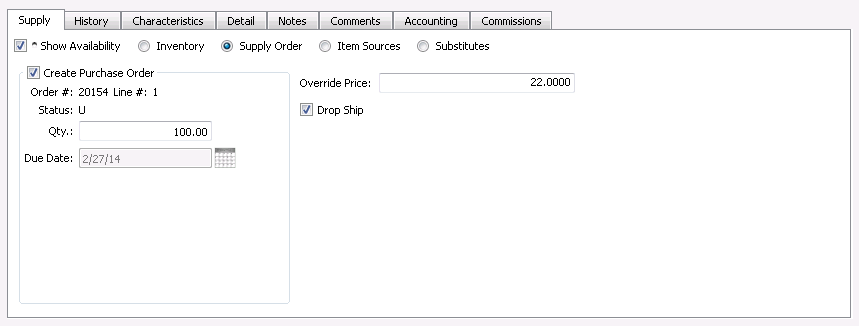
Supply Order information for bought item
If your site has enabled the Allow Inventory Receipt Cost Override option in the setup, then you will be able to override the default unit price here. This option applies only to average cost items.
Select this option if the item should be automatically shipped when the purchase order receipt is posted.
To see a list of item sources, select the Item Sources option on the tab. Available item sources will be displayed:

Available Item Sources
To display a list of substitutes for the selected item or site with availability information, select the option on the tab. The following will be displayed:

Available Substitutes
Substitutes are defined on the Item master. Right-click on an item in the list and select to set the selected item as a line item substitute. The original line item will be moved to the Substitute For field.
The following buttons are unique to this screen:
Select to view previous line items associated with the sales order.
Select to cancel the current sales order line item. Records of canceled line items will be retained for informational purposes. To view canceled line items associated with a sales order, select the Show Canceled Line Items option on the sales order header's tab.
To view historical information related to the sales order line item, select the tab. The following screen will appear:
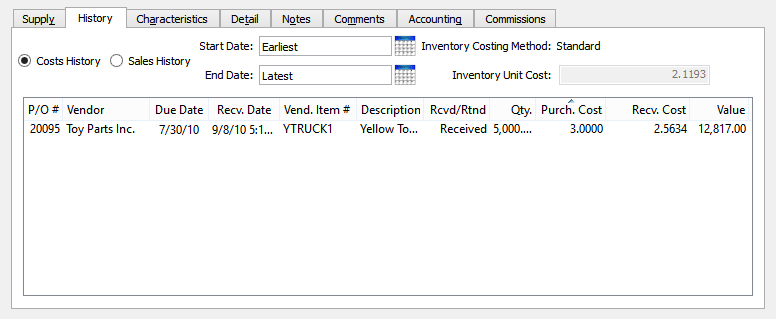
Costs History
When viewing costing history for the sales order line item, you will be presented with the following options:
Purchase orders entered on or after this date will be included in the display.
Purchase orders entered on or before this date will be included in the display.
Displays the item's inventory costing method (i.e., standard, average, or job).
Displays the item's inventory unit cost.
Display lists purchase orders for the item, using the specified date range.
To view sales history for the sales order line item, select the tab. The following screen will appear:

Sales History
When viewing sales history for the sales order line item, you will be presented with the following options:
Invoices entered on or after this date will be included in the display.
Invoices entered on or before this date will be included in the display.
Displays the total number of historical sales orders for the item, within the date range specified.
Displays the calculated average quantity per historical sales order.
Displays the item's inventory costing method (i.e., standard, average, or job).
Displays the item's inventory unit cost.
Display lists invoices for the item, using the specified date range.
If an item has characteristics associated with it, you have the option of linking those characteristics to a sales order line item. And, in the case where sales order demand automatically generates either a purchase request or a work order, the characteristics defined here will be inherited by those subsequent orders.
For configured items, an additional pricing field will be available on the Item Characteristic screen. This pricing information will be passed to sales order line items when particular configurations are sold. The price for configured items may vary depending on the characteristics selected at sales order entry time.
To associate characteristics with a sales order line item, select the tab at the bottom of the screen, as shown below:
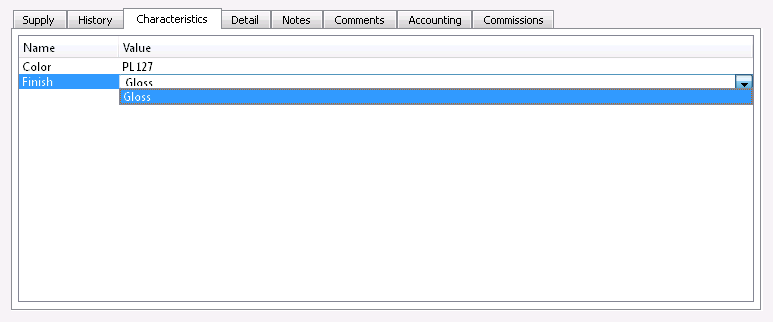
When selecting or editing characteristics for a sales order line item, you are presented with the following options:
Displays the name of any item characteristics associated with the item. Characteristics defined as item characteristics may be associated with items on the Item master.
Displays the default value associated with an item characteristic, but permits you to specify an alternate value. When associating characteristic values with a sales order line item, you have four options: 1) Select the default value; 2) select an alternate pre-defined value; 3) manually enter a new value in place of the pre-defined value; or 4) make no selection. Making no selection means the characteristics will not be associated with the sales order line item.
If the sales order item is a configured item (i.e., job or reference item), the Base Price option will be shown. Characteristics associated with configured items may have additional list prices associated with them. As a result, when characteristics are added to a sales order item, the overall price of the item may increase. The base price shows the price before any characteristic list prices have been added to the net unit price. To learn more about adding price characteristics to configured items, see Section 2.1, “Enter New Item”.
During the creation of a new sales order for a configured item, the work order is imploded and the characteristics will remain enabled and may be edited. When the button is clicked, the work order characteristics are updated and the work order is exploded. To edit the sales order item for a configured item, the work order needs to be manually imploded first. This will enable the characteristics and allow editing. When the button is clicked, the work order characteristics will be updated and the work order exploded.
To view costs or adjust tax information for a sales order line item, select the tab at the bottom of the screen, as shown below:
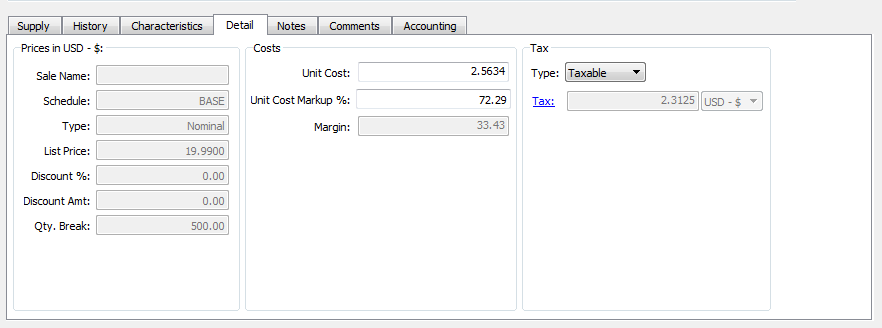
When viewing costs or adjusting tax information for a sales order line item, you are presented with the following options:
Depending on configuration settings, the unit cost displays the wholesale price or the standard or average inventory cost. For average cost items having zero QOH, the standard cost will be used instead of the average cost, if it exists.
This value can be changed if the user has the necessary permissions. A change in this value will result in a new net unit price.
Displays the sales list price per unit.
Displays the price given to the specified customer. Special customer prices can be set for individual customers or customer groups by using a pricing schedule.
Displays the percentage discount off the list price. Indicates the difference between the list price for an item and the net unit price as a percentage. This is the margin between the net unit price and the list price.
Displays the effective markup which is based on the unit cost and net unit price values.
Like the unit cost, this value can be changed by a user with sufficient permissions and such a change will adjust net unit price.
Displays the difference between extended price and extended cost.
The following tax options are available, should you need to override the tax selection settings for the line item:
Specify the tax type for the sales order item.
Displays the amount of tax to be charged for the sales order line item quantity. To get a detailed view of the tax calculation, click on the link using your mouse.
To enter notes related to a sales order line item, select the tab at the bottom of the screen, as shown below:
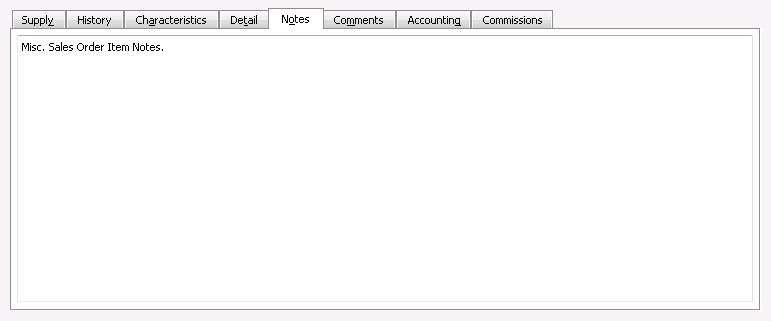
When adding notes related to a sales order line item, you are presented with the following options:
This is a scrolling text field with word-wrapping for entering general notes related to the sales order line item.
If a sales order item is marked to create a work order, the production notes for the created work order will contain the sales order number, the customer name, and any additional sales order line item notes.
To add comments related to a sales order line item, select the tab. The following screen will appear:
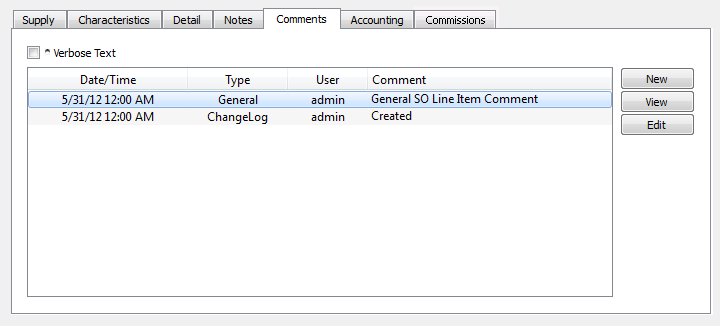
Whenever sales order line items are created or their quantities are changed, the system will automatically generate a comment, which will appear in the list of line item comments.
When adding or reviewing comments, you are presented with the following options:
Select to display all comments in the list in an expanded view which includes the entire text of each comment. To edit a comment, simply select the link next to the comment. That link will not be shown for changelog comments, which can't be edited. If the Verbose Text option is not selected, the comment list will display only header level information for each comment.
Display lists comments related to the record.
The following buttons are available:
Opens screen for creating a new comment.
Highlight a comment and then select this button to reach a read-only view of the Edit screen.
Enables you to edit highlighted comments—as long as the comments are not changelog comments. ChangeLog comments are system-generated and may not be edited. The Edit screen is the same as that for creating a new comment—except that when editing, the fields will contain comment information. Double-clicking on a comment will also bring you to the editing screen.
To enter a new comment, select the button. The following screen will appear:

Select a comment type from the drop-down list to classify the comment. This is a required step. Comment types may be system-defined (i.e., changelog and general) or user-defined, as described in Section 13.2.3, “Comment Types”. Once you have specified a comment type, begin typing your comment in the main text area. The text area features word-wrapping and scroll-bar support for longer comments.
The following buttons are unique to this screen:
Select to show the complete list (i.e., thread) of comments associated with the record. To hide the list, simply select the button again. The comment thread will show the most recent comment first.
To define an alternate cost of sales account for a sales order line item, select the tab at the bottom of the screen, as shown below:
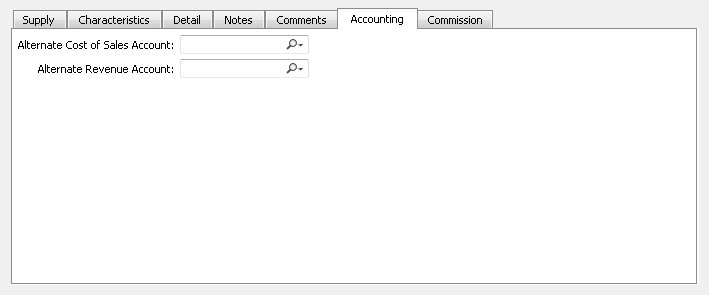
When defining an alternate cost of sales account or alternate revenue account for a sales order line item, you are presented with the following options:
Specify an alternate account to be used for the cost of sales. This account will be used instead of the typical account pre-defined in the sales accounts assignments.
Specify an alternate account to be used as the revenue account. This account will be used instead of the typical account predefined in the receivables assignments.
To enter the net unit price for a sales order line item, select the lookup feature located to the right of the Net Unit Price field. The following screen will appear:
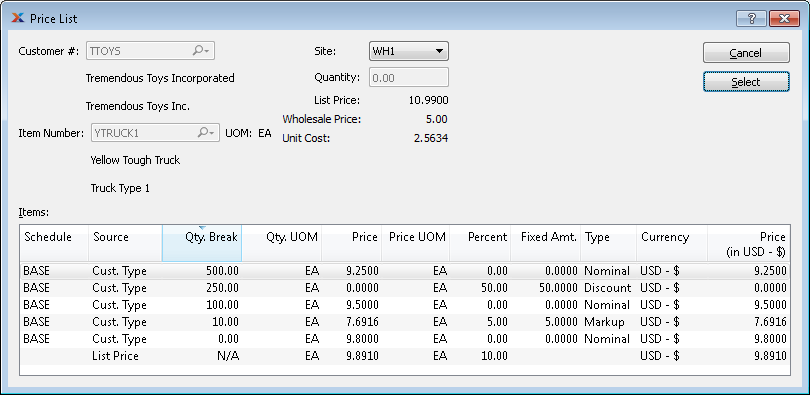
When entering the net unit price for a sales order line item, you are presented with the following options:
Displays the customer associated with the specified sales order. The name of the customer will also be displayed.
Displays the item number associated with the specified sales order line item.
Inventory unit of measure.
Displays the site associated with the line item.
Displays line item quantity specified on previous screen.
Used in conjunction with unit cost to calculate the net price when markup pricing is used.
Displays the wholesale price for the line item.
The unit cost and site cost are used to calculate the net price when markup pricing is used.
Display lists available pricing for the specified sales order line item. Currency values and conversions currency will also be shown if your system is configured to use multiple currencies.
The following buttons are unique to this screen:
Highlight a price from the list of prices, then select this button to enter the price in the Net Unit Price field on the previous screen.